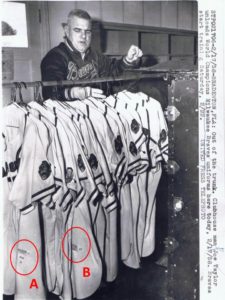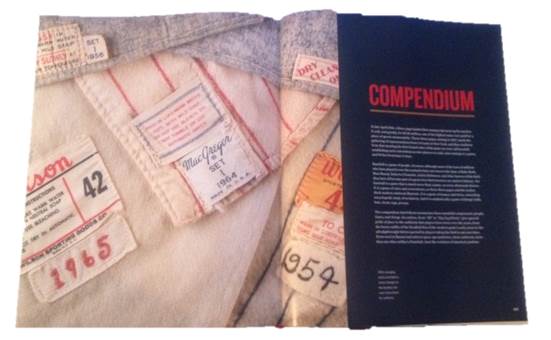One of the things I have always felt that was sorely needed with respect to major league game worn jerseys was a standard, accurate, and relevant vocabulary. The lack of a professional vocabulary hinders the ability to attract new, and at times, a more sophisticated collector. At the same time, a lack of a professional vocabulary continues to subsidize the standard of “it’s good because I say so” with respect to evaluations. But do terms, words, and phrases really make difference? I think they do. For example, is there a difference between a prototype and a salesman sample? If so, what are the differences? How do you spot these differences and understand their value or how they can be nefariously passed off as game worn jerseys?
In the Compendium Section of Game Worn, we have included an entry for “Extended Organizational Use.” In part, that entry reads: Term used to describe that fact that major league organizations retained uniforms for subsequent use at the major league level or during spring training when requirements for on hand uniforms exceeded what would have been available. Many player number/name changes on uniforms or other alterations were performed to meet these requirements. Contrary to what has been stated for years, changes as mentioned above were not always signs that a uniform was “sent down to the minors.”
For years, far too many of the “house hold names in authentication” have accounted for changes in names, numbers, patches etc… on uniforms using the “minor league” excuse because it was easy and plausible; requiring very little thought and even less real research. This is not to say uniforms were not sent or sold to minor league teams and affiliates, but it should never have become a standard disclaimer. As a uniform historian and researcher I feel this has done more harm than good since it tends to reinforce a very low bar for what should be required in offering a credible opinion. It also tends to stifle continued research and study that helps to explain and account for other valuable information.
In any given month, I spend hours culling through auctions, E-Bay listings, and print publications not already in my reference library for images and information that enable me to have a more complete picture and understanding of major league uniforms of the 20th century. Recently I had occasion to find and purchase this wire photograph from February of 1958. While others may not have thought twice about this image, for me it was veritable gold mine of information. Let’s have some fun and dig through it.

- This image confirms and reinforces the definition of “Extended Organizational Use”. Here we can objectively see that the Milwaukee Braves made use of uniforms from 1953 (A) and 1955 (B) in spring training in 1958. These two uniforms, and any others issued prior to 1957 have had the patches changed from the War Bonnet Brave to the Screaming Brave.
- This image (A) confirms that the 1953 Milwaukee Braves uniforms were manufactured by Horace Partridge, the same manufacturer used when the team played in Boston. Remember, uniforms for the coming season were ordered during in spring training, and in 1953 the Braves went into spring training as the Boston Braves.
- This image (B) confirms the switch to Wilson products once the team was firmly established in Milwaukee by 1955. (In fact, the 1954 Braves uniforms were manufactured by Wilson).
- The image shows objective information that can used to evaluate the tagging of 1950s Milwaukee Braves uniforms. Or you could just accept the standard line of the frequently offered disclaimer of “the jersey has all correct tagging.”
- The image helps to explain why 1950s Milwaukee Braves uniforms are difficult to find in all original condition, or in any condition at all since the parent organization used them to the point where retention was no longer practical based on repeated and continued “Extended Organizational Use.”
The bottom line, coming at the bottom of this article is that words, terms, and phrases do matter. As you consider adding uniforms to your collection, make sure the person offering the opinion clearly knows and shows what they are talking about.
Dave Grob

